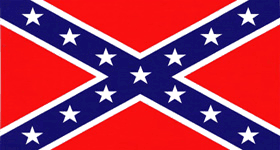 |
Civil War Battles |
|
State War Records |
| AL - AK - AZ - AR - CA - CO - CT - DE - FL - GA - HI - ID - IL - IN - IA - KS - KY - LA - MA - MD - ME - MI - MN - MS - MO - MT - NE - NV - NH - NJ - NM - NY - NC - ND - OH - OK - OR - PA - RI - SC - SD - TN - TX - UT - VT - VA - WA - WV - WI - WY |
The Battle of Bean's Station
December 14, 1863 in Grainger County, Tennessee
 |
|||||||||||||||||
|
Lt. Gen. James Longstreet broke off the Siege of Knoxville the night of December 4th, and his troops began a 5-day retreat north to Rogersville in East Tennessee. A timid pursuit column commanded by Maj. Gen. John G. Parke set out from the city shortly afterward, following in Longstreet's path but always remaining a few days behind. The Union pursuit and the fight at Bean's Station concluded the Knoxville Campaign.
Traveling northeast, paralleling the East Tennessee & Virginia Railroad line, Longstreet's men reached the community of Rutledge on the 6th, then pressed on. On the 9th, Parke reached Rutledge with the body of his column. Brig. Gen. James M. Shackelford, with 4,000 cavalry and infantry, stayed in Parke's advance, searching his front for Longstreet. The Confederates reached Rogersville, several miles northeast of Rutledge, on the 9th.
Shackelford's probing went on through the 13th. His presence at Bean's Station, hard by the banks of the Holston River, tempted Longstreet, who ordered a force of Confederates to backtrack along the retreat route and take the hamlet. Longstreet planned a 3-pronged attack to try to catch the Federals in a vice. A division of infantry under Brig. Gen. Bushrod R. Johnson would make a direct march to the village from Rogersville. Maj. Gen. William T. Martin would take 4 cavalry brigades by a circuitous mountain route to the banks of the Holston, cross the river south of the Federals, and attack them in flank. Brig. Gen. William E. Jones would take an even longer route to the far side of the Union rear, descind the north side of the Clinch mountains with 2 cavalry brigades, and seal the pass, Bean's Gap. The Union's escape route would be cut off. Batteries from Col. E. Porter Alexander's artillery would lend support.
Late on the night of the 13th, Johnson's men and an advance of 100 cavalry left camp and, by 2:00 A.M. on the 14th, were driving in Union pickets 3 miles from Bean's Station. Federals twice tried making a stand and sent an alarm back to Shackelford. The Union commander deployed his men in the village, positioning his available artillery on 2 hills to the northwest behind the hamlet and on a southwestern rise beyond the fields.
As Confederate skirmishers came over the foothills east of the village, Shackelford's artillery opened fire. Johnson's men splashed across the Holston and tried turning the Union's left, then hit their right. Confederate artillery dueled with Union cannon from positions on hilkls in front of the village. Union troops in the village hotel opened up a hot fire on flanking Confederates, beginning a fight that lasted all day.
Elsewhere on the field, Confederate flanking moves were slow and inconclusive. Martin's cavalry, expected to ride in from the south, never appeared that day. Longstreet personally commanded the assaults and ordered more troops from Rogersville to tip the balance, finally driving the Union command out of Bean's Station. At nightfall, Shackelford's men were retreating through Bean's Gap to Blain's Cross Roads, 3 miles away, most escaping before Jones's cavalry were in place to stop them. The Confederates captured only a few trailing wagons from the retreating force.
The next morning, Longstreet sent Brig. Gen. Joseph B. Kershaw and his division after them, but when Kershaw approached the crossroads, he found Shackelford's men dug in behind rail breastworks, in a stronger position than the day before. The Federals were allowed to retreat without further incident.
Longstreet soon went into winter quarters at Russellville. Their success meant little to Confederate efforts except to prevent disaster.
